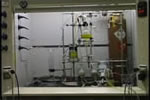
![]()
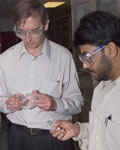 Hydrogen is not an energy source, but is an energy vector or carrier. This means that it has to be produced from one of the primary energy sources: fossil fuels, nuclear, solar, wind, biomass, hydro, geothermal and urban waste resources. All the energy we use, including hydrogen, must be produced from one of these three primary energy resources. If you're interested learning more about "Hydrogen Production" issues, please take a look at our Hydrogen Basics .
Hydrogen is not an energy source, but is an energy vector or carrier. This means that it has to be produced from one of the primary energy sources: fossil fuels, nuclear, solar, wind, biomass, hydro, geothermal and urban waste resources. All the energy we use, including hydrogen, must be produced from one of these three primary energy resources. If you're interested learning more about "Hydrogen Production" issues, please take a look at our Hydrogen Basics .
For many years, FSEC has been researching hydrogen production methods. By joining with government agencies such as the U.S. Department of Energy and NASA, FSEC is renewing its hydrogen production research commitment. Please explore the list of projects to see what we're working on.
UV-Photochemical Recovery of Sulfur and Hydrogen Sulfide
The removal of sulfur from crude petroleum is a major process in oil refinery operation worldwide. The objective of this research was to develop a photochemical sulfur recovery scheme that decomposes hydrogen sulfide, the predominant sulfurous waste product of hydrosulfurization, to its constituent elements. Two useful products that are obtained: sulfur, that can be sold as a commodity, and hydrogen gas, that can be likewise sold, used for clean process heat, or returned to the hydrosulfurization plant for reuse. This new process is in contrast to existing sulfur recovery technologies where the hydrogen and its energy content are lost. The project was funded by Gulf Coast Hazardous Substance Research Center and the Environmental Protection Agency.
|
Integrated Renewable Hydrogen Utility System
The objective of this work was to develop an efficient tool to assist in the design and evaluation of integrated solar hydrogen production and storage energy system. The main components of the integrated system are a photovoltaic array, PEM electrolyzer, PEM fuel cell, battery, pressurized hydrogen storage unit, controller, and electric load. The modeling was performed using a modified TRNSYS simulation software. System size, performance, and cost trade-offs were analyzed by simulating two short-term energy storage scenarios: one with a large battery storage capacity (approximately one day) and one with a much smaller capacity (two hours). Results showed that a system with a small battery storage capacity is more desirable in the interest of system renewability, however it is more capital cost intensive. The project was funded by Energy Partners, Inc. of Florida and it was part of a DOE project.
Production of Hydrogen by Solar Thermochemical Water-Splitting Cycles
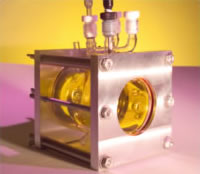 |
| Experimental photoreactor for high temperature solar powered hydrogen production (Photo: N. Waters) |
|---|
In October 2004, FSEC jointly with the Science Applications International Corporation of San Diego, CA was awarded a competitively procured project from DOE to develop a solar thermochemical process for the production of hydrogen from water. This is an R&D project leading to the demonstration of a cost-effective water-splitting cycle for hydrogen production using high-flux solar concentrators. Past research in solar thermochemical cycles has focused on two-step processes involving metal oxides that utilize only the thermal component of the solar spectrum. FSEC’s approach utilizes the high-energy photons available within the solar spectrum to stimulate the chemical reactions to split water more efficiently. The FSEC proposed cycle received the Innovative Technology Award at the 5th World Hydrogen Energy Conference in Yokohama , Japan – the only such award given to researchers from the U.S. A provisional patent on this process has been filed with the U.S. PTO on behalf of FSEC. This project was funded by the U.S. Department of Energy.
Hydrogen Production by a Dual Bed Process
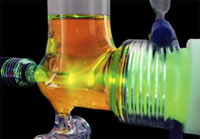 |
| Photochemical hydrogen gas evolution experiment, FSEC H2 Lab (Photo: S. Spencer) |
|---|
The dual bed project was a solar driven method to produce hydrogen by splitting water. The concept involved a novel photoelectrochemical water splitting method that produces hydrogen and oxygen in separate chambers. This work utilized colloidal semiconductor powders and organic dyestuff as the photoelectrochemical materials. The research also teamed FSEC and Swiss researchers to investigate the water-splitting ability of specially immobilized tungsten oxide. FSEC researchers later worked with Japanese collaborators to study nickel-loaded titanium dioxide. This project was funded by the U.S. Department of Energy.
Technoeconomic Analysis of Hydrogen Production Process
The objective of this project was to systematically analyze the issues of cost, safety, performance, environmental impact and barriers to commercialization associated with production of hydrogen by means of three technology areas not previously investigated by the DOE Hydrogen Program. The three areas were: solar thermochemical cycles for splitting water, solar thermochemical cycles for splitting hydrogen sulfide, and catalyzed micro-reformer for splitting ammonia. These three processes are high temperature solar thermochemical cycles and each have high efficiencies for the production of hydrogen. This project was funded by the U.S. Department of Energy.
Thermocatalytic CO2-free Production of Hydrogen from Hydrocarbon Fuels
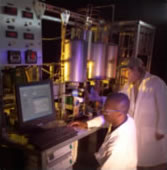 |
| Exp. thermocatalytic hydrogen production, FSEC H2 Lab, F. Smith and N. Muradov (Photo: N. Waters) |
|---|
The main objective of this project is the development of an economically viable catalytic process for production of hydrogen from natural gas (or other hydrocarbon fuels) with minimal environmental impact. Thermocatalytic decomposition of light hydrocarbons is a viable approach to the production of hydrogen and solid carbon. The process operates at moderate temperatures (less than 900°C) in an air/water-free environment, which eliminates the concurrent production of carbon oxides. The important feature of the process is that the reaction is catalyzed by carbon particulates produced in the process, so no external catalyst is required (except during the start-up). This results in the following advantages: (1) no CO/CO2 byproducts are generated during hydrocarbon decomposition stage, (2) no expensive catalysts are used in the process, (3) several valuable forms of carbon can be produced in the process depending on the process conditions, (4) CO2 emissions could be eliminated or drastically reduced (compared to conventional processes). FSEC has received a U. S. Patent (No. 6,670,058 B2) for this process. Techno-economic analysis of hydrogen and carbon production by thermocatalytic decomposition of natural gas was conducted in cooperation with NREL. This project was funded by the U.S. Department of Energy.
Local Hydrogen Production via Catalytic Reformation of Fossil and Renewable Feedstocks
The objective of this project is to develop economically viable process for the production of high purity hydrogen at the NASA-KSC site from locally available fossil and renewable feedstocks with minimal environmental impact. The innovative approach is based on the development of a feedstock-flexible catalytic process that allows converting both fossil (e.g., natural gas, NG) and renewable (landfill gas, LFG) feedstocks into high-purity hydrogen gas suitable for liquefaction. The work is based on the development of a feedstock-flexible catalytic process that allows converting both fossil (e.g., natural gas) and renewable feedstocks (landfill gas, LFG) into high-purity hydrogen gas suitable for liquefaction. The project explores two technological approaches to local hydrogen production: (i) direct reformation of landfill gas (LFG) from the nearby Cocoa facility, and (ii) catalytic pyrolysis of methane into hydrogen and value-added carbon products. The first approach could be conveniently combined with the reformation of other renewable feedstocks, e.g., biogas, bio-ethanol, the producer gas from citrus waste pyrolysis/gasification unit. In contrast to conventional processes, the significant part of the feedstock carbon will end up in the form of valuable carbon byproducts (activated carbon, pyrolytic graphite, carbon filaments) rather than CO2. Marketing of carbon byproduct will reduce the net cost of hydrogen production. This project was funded by NASA.
Hydrogen Production via Supercritical Steam Reformation of Used Lube Oils
The primary goal of this activity is to develop a hydrogen production process via supercritical steam reformation of lube oils. The significance of this project is that it can produce hydrogen for NASA use from a locally available resource (i.e. used lubricating oils - every year, Floridians generate close to 45 million gallons of it) at a cost that is potentially less than 40¢ per kg of hydrogen generated. Presently, NASA pays more than $4.50 per kg of liquid hydrogen (made by steam reformation of natural gas in Louisiana and shipped by tanker trailers to KSC). In Florida, within a short distance from KSC, sufficient quantities of used lube oil are available to meet hydrogen demand for more than 100 Shuttle equivalent launches per year. Lube oil is a complex mixture of aliphatic and polycyclic hydrocarbons. Both synthetic and mineral oils contain a high concentration of hydrogen (about 13-14 weight percentage) This project has developed a thermocatalytic process that converts lube oils to hydrogen and other valuable low molecular weight hydrocarbons. The lube oil reformation experiments have been carried out using several commercially available dehydrogenation catalysts for a range of reactor temperatures and pressures, residence times and steam to carbon ratios. Data obtained to date are given and discussed. This project was funded by NASA.
Hydrogen Production from Florida's Sub-quality Natural Gas
The objective of this project was to develop a two-step process using SQNGs as the hydrogen source. A two-step process has been conceived in which the first step is hydrocarbon processing (pyrolysis/partial oxidation/steam reforming) and the second involves the hydrogen sulfide reforming of methane (HSRM) to efficiently produce hydrogen and carbon disulfide. The significance of this approach is that it is a purely thermal process. No hydrogen sulfide separation would be required prior to the hydrocarbon processing; that is, hydrocarbons would be processed in the presence of hydrogen sulfide. The thermochemical equilibrium calculations conducted at FSEC indicate that hydrogen sulfide contained in SQNG remains unreacted and can be treated as an inert gas within the temperature range of the pyrolysis reactor used to crack hydrocarbons. Our analysis showed that hydrocarbons and hydrogen sulfide in SQNG could be treated separately to produce hydrogen without requiring H2S separation first. The key enabling technology for the first step is finding a sulfur tolerant catalyst. In the second step, we used a conventional thermal catalytic process. This project was funded by NASA.
Photoelectrochemical Water Splitting for Hydrogen Production Using Multiple Bandgap Combination of Photovoltaic-Cell and Photocatalyst
The operating voltage of present photovoltaic (PV) cells cannot supply the overvoltage required for water splitting. The objective of this project is to develop photoelectrochemical (PEC) cells with multiple bandgap tandem of PV cell and a photocatalyst that can be activated by infrared (IR) photons transmitted through PV cell for efficient and economic production of hydrogen and oxygen by water splitting. The proposed project is unique and distinct from conventional PEC water splitting technique and the conventional concept of multiple band gap used widely in solid-state PV technology in the form of tandem cells. Here the bandgap regions are different, the chosen PV cell types are either commercially available or are amenable to economic mass production, the PV cells are not in direct contact with the electrolyte solution and the photocatalyst need not be grown directly over the PV cell as is usually the case with solid-state tandem PV cells. During Phase 3 of this work, FSEC PV Materials Lab has achieved a PEC efficiency of 5.25%. This project was funded by NASA.
Solar-Powered Hydrogen Production via a High Temperature Photocatalytic Water Splitting Cycle
Solar-driven thermochemical water splitting cycles (TCWSCs) provide an energy efficient and environmentally attractive method for generating hydrogen. Solar-powered TCWSCs utilize both thermal (i.e. high temperature heat) and light (i.e. quantum energy) components of the solar resource, thus boosting the overall solar-to-hydrogen energy conversion efficiency compared to those with heat-only input. At FSEC, a new solar-powered TCWSC, sulfur dioxide (SO2)/sulfuric acid cycle, is under research and development. FSEC's cycle - a novel hybrid photo-thermochemical sulfur-ammonia (S-A) cycle, is a modification of the well-known Bowman-Westinghouse (B-W) hybrid cycle wherein the electrochemical step is replaced by a photocatalytic process. The main reaction (unique to FSEC's S-A cycle) is the light-induced photocatalytic production of hydrogen and ammonium sulfate from an aqueous ammonium sulfite solution. Ammonium sulfate product is processed to generate oxygen and recover ammonia and SO2. Ammonia and sulfur dioxide are then recycled and reacted with water to regenerate ammonium sulfite. This project was funded by NASA.
Development of Hydrogen Separation Membranes for Space Applications
The objectives of this work are to prepare and characterize perovskite ceramic oxides composed of terbium-doped strontium cerate (SrCe0.95Tb0.05O3-δ). The membrane systems will be synthesized in the form of thin films (1-3 µm thick) on porous supports by spin-coating using ethylene glycol polymeric precursor. In addition, the membrane systems will be fabricated as disks (1-2 mm thick) using the citrate wet chemical technique. The synthesized ceramic disks and thin films will be characterized as a function of hydrogen permeability, stoichiometry, film thickness, and morphology.
Hydrogen permeation will be carried out using in-house hydrogen permeation unit. The chemical stability and durability of the membranes will be addressed by exposing the membranes to both representative and accelerated conditions in order to quantify the kinetics of the reaction. The miscibility and phase behavior of the membranes will be modeled using Fact Sage simulator for optimum processing performance. This project was funded by NASA.

